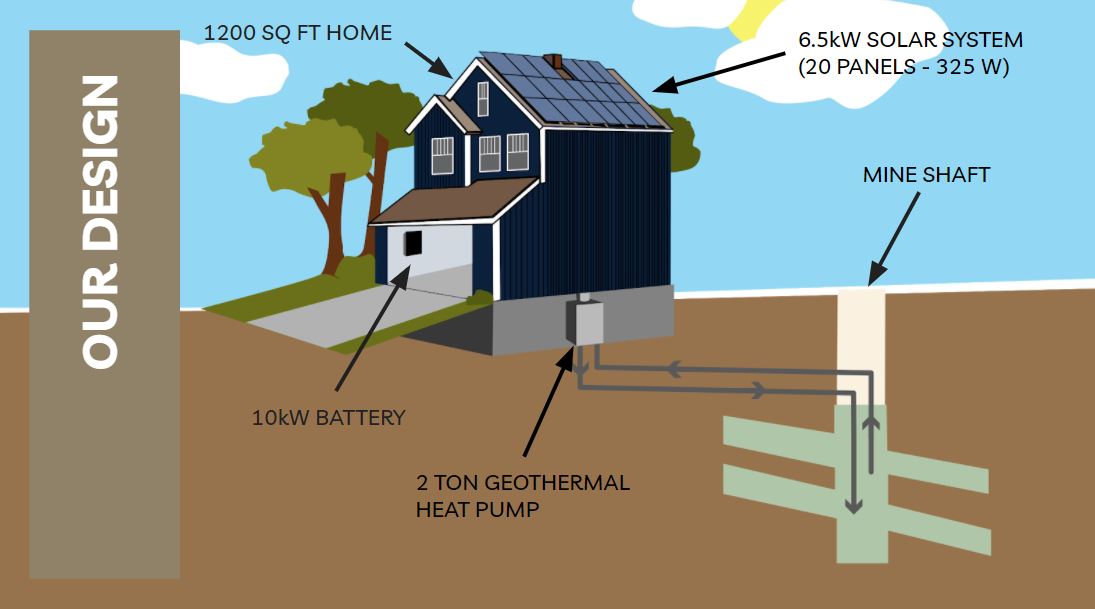Instructions
The map below shows all of the mines in the Keweenaw region. Use this map to find an approximate distance in feet between the closest mine shaft and the potential build site. This is the distance that will be used in our calculator. After this, follow the prompts as instructed.

What
Our enterprise team through Alternative Energy Enterprise of Michigan Technological University created a system design for the Copper Country Habitat for Humanity which consisted of a 2-ton geothermal heat pump, a 6.5kW photovoltaic (PV) solar system, and a 10kWh battery. The design took advantage of a retired mine shaft to avoid additional digging associated with installing a geothermal system.
Our system That we previously designed demonstrated a monthly saving of about $120 with a payback period of initial costs from the savings being 23 years.
We decided that we should make a tool that would allow users to see calculations for a more personalized GeoSolar system. That is where this page comes in. We designed this page to allow you to calculate a more personalized estimate based on criteria that is interactive and more specific to you.

Why
Houghton County has one of the most expensive electricity costs in the nation at about $0.25 per kwh after services and fees. Additionally, the electricity from the grid is, by about 90% in the US, sourced from nonrenewable resources known to cause and accelerate the damages of climate change.
Natural gas, while cheap, is a major pollutant which not only accelerates climate change globally, but also, due to the extraction method of fracking, leads to additional earthquakes and demands the release of over one thousand chemicals many known to cause cancer and other harmful effects on human life.
The work of both the geothermal heat pump and the photovoltaic solar panels allows for affordable heating and cooling. Additionally, they're renewable sources of energy, thus only depending on the natural heating of the earth and energy from sunlight. This system is proven to save money over time compared to natural gas and electric grid sourced energy for homes here in Houghton County.

The Impact
You might be wondering: what will switching over to a renewable source of energy really do for the environment? Well, we're glad you asked. In terms of CO2 emissions, switching over to our completely clean system is the equivalent of saving 350 trees, per year [2][3]. See, the effects of climate change weren't caused in a day, a year, or even a decade. It's the culmination of many acts of negligence over the course of several generations. In order to help reverse the effects, small lifestyle changes over the course of time is the only way to make a lasting difference. Now, this might sound a bit scary, hearing you have to change the way you live to make a significant impact. But our renewable energy system is as close to "set-and-forget" as you can manage: once your GeoSolar system is in place, there's nothing more to do but start telling your friends about how easy leaving a smaller carbon footprint really is!
Think about it: how many times have you tried to be more environmentally friendly? Whether it's cutting down on wasting food, time in the shower, items thrown in the trash that could be recycled, even turning to a more sustainable diet; all of these efforts are honorable, but they're hardly as effective as our GeoSolar system, particularly because none of these lifestyle changes are nearly as permanent as switching to a GeoSolar system [4]. The best part is that you won't even notice the difference in your lifestyle! Typically, you have to put aside the beef for the tofu, not turn the shower handle quite as far as you'd like, or make time to compost the food scraps you've salvaged over for weeks in order to reduce your carbon footprint. But by changing the source of power for each and every action, you make an incredible impact on our environment, all while saving money on your energy bills. And you still get to enjoy that juicy hamburger, knowing the stove that cooked it didn't emit a single ounce of CO2 [5].

Information Before Starting
Solar Panels:The sun is a renewable energy source. The sun can be a free source of energy unlike gasoline, coal, or other non-renewable sources. However, there must be a way to harness the power from the sun. Photovoltaic (PV) solar panels can convert the energy from the sun into electricity. Photovoltaic comes from light (photo) and electrical potential (voltaic) put together. Solar panels generate Direct Current (DC) from the sun.
The angle of a panel or array of panels with respect to the earth is very important. The optimal angle is different for each hour of the day. However, if moving panels are too expensive or a hassle, the optimal angle anywhere is generally the same number of degrees at your position or latitude.
Location of panels is important as well. They should be put in a place that gets almost no shade year-round.
Solar panels are almost always oriented either portrait or landscape, and each has their own advantages and disadvantages. First off, there are a few aspects that are similar between portrait and landscape. Both options require the same level of maintenance. Additionally, orientation does not affect the number of microinverters, or optimizers needed for the array [2]. Portrait panels are the most common forms of installation for mounted systems because the mounting system is cheaper, and it is easier to have a continuous row of panels. Depending on how the panels are installed and where they are installed on the roof, portrait panels may be slightly more efficient at producing energy than if they were installed horizontally due to the layout of a solar panel. Even so, in many situations both orientations produce near identical amounts of energy [2].
The grid sends Alternating Current (AC) to houses and businesses. Therefore, normal homes run on AC power. If solar panels are to be used, the DC power coming from the solar panels must be changed into AC power. This can be done using an inverter or microinverters. Once connected to an inverter, the power can be used by homes and potentially sold back to the grid.
Power loss occurs in a solar array when there is a mismatch in power production in a string of panels, or even a string of cells within a module. This mismatch is caused by nonideal conditions. For panels in series, one panel underperforming slows down the entire string. For sub module power, bypass diodes are employed to prevent damage to the panel [3]. Microinverters are a per-module unit that converts the DC voltage to AC. Optimizers isolate each panel or group of panels from the system, all tying into a string converter. This also eliminates the issue of imperfect behavior in a string of panels. The difference between these two options must be weighed to decide on which one works best for the given system. Enphase’s microinverter has a peak efficiency of around 97% [4]. SolarEdge sells a power optimizer peak efficiency of around 99.5% [5]. Power optimizers are the cheaper of the two options by a wide margin.
When using an inverter, some power is lost in the change from DC to AC power. Therefore, if possible, it is recommended to have some things that can run on DC power to be connected to the solar panels before the inverter so that less is lost. There are several things that can be used before the inverter including but not limited to DC LED lights and the storage batteries.
Speaking of batteries, solar panels are much more useful if used with batteries. Solar panels collect energy only when the sun is out. Without batteries, solar panels can only provide power during the day. With batteries and if there are enough solar panels to produce more electricity than is needed for a home, the extra power can be stored in the batteries and used in the evening or when clouds are blocking the sun.
 Geothermal Heat Pumps:
Geothermal Heat Pumps:
The function of a heat pump is to transfer heat energy from water to air. Heat pumps can be used to heat buildings, homes, or other applications. It does this using a working fluid, or a refrigerant. This working fluid goes through four stages. The first stage is at the evaporator, where the heat is transferred from the water to the working fluid. The second stage is at the compressor, where the working fluid is compressed. The third stage is at the condenser, where the heat is transferred from the working fluid to the air. Finally, the fourth stage is at the expansion valve, where the working fluid is expanded. This process is then repeated. Also, a reversing valve can be switched to reverse this process, and transfer heat from the air to the water. This allows the heat pump to act as a cooling unit, too.